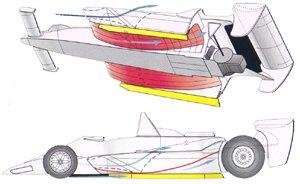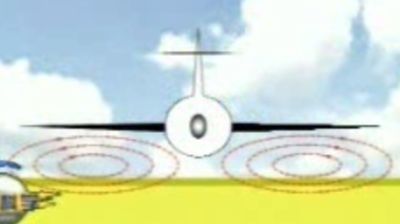Racing Aerodynamics for Physics
In regular Physics class, we're coming up on the study of gases, including Bernoulli's principle. I'm looking up examples on Youtube to show in class (curving a soccer ball kick, tornado tearing the roof off a house) and I find myself getting deeper and deeper into the fascinating world of... F1 aerodynamics.
From what I pieced together, early-on racecar designers figured out that having a racecar that would stick to the track meant that you could go around corners more quickly without skidding. The downward force that stuck the car is called the Ground Effect, and has lot of other applications.

As I understand it, the earliest groundeffect was achieved by using tunnels under the car that were narrower at the middle and wider at the edges so that the air was compressed and then decompressed as it went under the car. This creates a low pressure zone at the middle bottom of the car, keeping it "sucked" onto the track. In physics we call this the Venturi effect. Diffusers, which spread the air at the back of the car, act in a similar way but get around new rules against tunnels on the underbody of the car.
Pretty soon every car had these tunnels. Then a wider engine came along that didn't have room for these tunnels, so one car team installed a fan on the back of their car (the "fancar") that served to cool the motor as well as suck the air through the bottom of the car and create a lower pressure zone there.
The fan was so effective that other teams complained, but by then the aerodynamics teams that started using aerofoils, basically inverted airplane wings that provide "reverse lift" to push the cars down. Wings are attached at the front and back of the cars in positions that maximize their contact with air flow and provide an even downforce. The position and angle of the wings can be customized to the curviness of different tracks. Now everybody wings too.

An interesting thing is that "ground effect" in the world of flight refers to an increase in lift that winged objects experience when they fly close to the ground due to the vortices coming off the ends of the wings interacting with the surface of the ground. It's a force in the opposite direction to that desired by racecar designers.
Another interesting thing is the social dynamics in the aerodynamics "race" for the fastest car. As one astute interviewee said, each time a racing team makes another technological breakthrough that allows faster racecars the other teams simultaneously rush to get the same feature on their cars and make a stink about it to get it banned by the governing body, who usually either bans or limits the use of the new technology in the name of safety. And by safety, they mean ensuring driver safety by keeping cars from going too fast! Amazing.
(I'm thinking this would make a good MetaFilter front-page post.)


0 Comments:
Post a Comment
« Home
Post a Comment